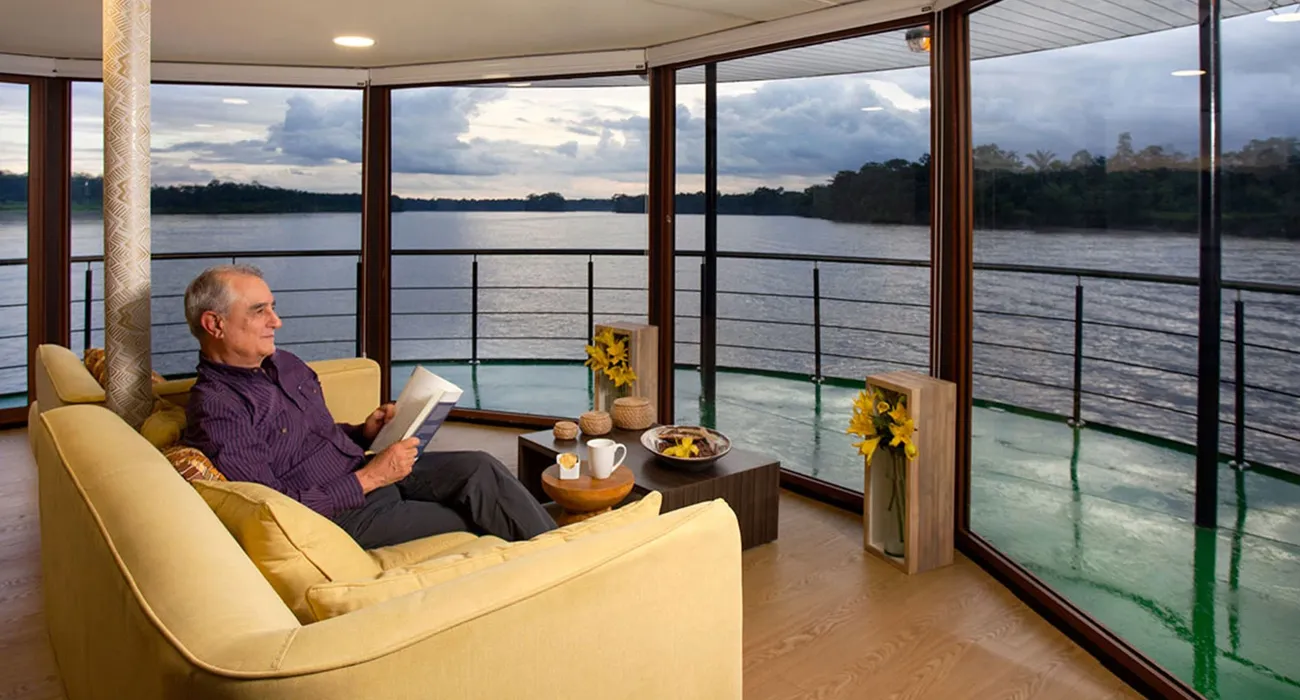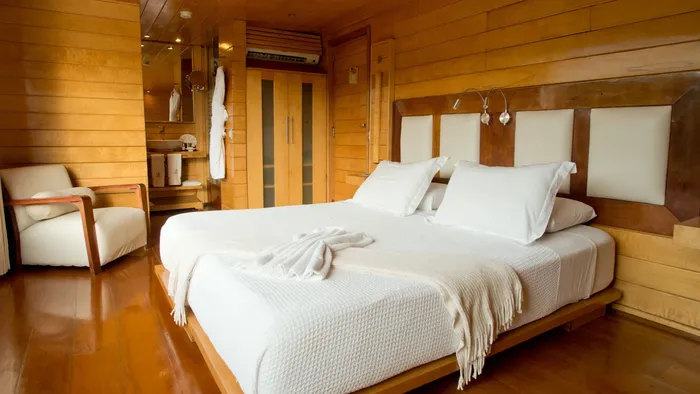A river cruise is one of the best ways to experience Amazonia. The Amazon Rainforest covers 40% of the continent. A vast network of tributaries feed this forest.
And cruises allow you to get deeper into the rainforest. On guided tours, you can experience incredible wildlife and beautiful scenery.
But when is the best time to go?
As you will be in the tropics there are not the usual seasons of temperate regions. Instead, you just have a wet and dry season. And in the rainforest, this is sometimes better described as a high and low water season.
Tropical temperature, rain and humidity are then all part of the experience. The intensity of rain is a little more over the wetter season. But these factors don't change much month to month.
There are, however, some differences.
Here we present some information for helping you decide when the best time is for your Amazon River Cruise.
Amazon Rainforest Temperature
The difference in daytime and night-time temperature is higher than between months. This is because of the lack of seasons.
The average nightly temperature is around 70 degrees Fahrenheit (20 degrees Celsius). And so you may want to take a few warm clothes for night times.
Amazon Rainforest Rains
The rain is what allows this lush and highly diverse forest to support an incredibly rich amount of life.
Even in the dry season, heavy rain is to be expected. And a typical year in the Amazon experiences around 200 rainy days. But no matter if you’re in the high water or low water season, rain rarely falls all day.
When it does rain, it often starts in the late afternoon. This is because water has been evaporating and accumulating in the clouds since morning. The rain usually clears by the following day. And you will have another morning & afternoon of wildlife watching.
Sometimes the rain will fall during the day, but is often in short bursts. Cruises simply delay activities until it clears. If you get caught on an expedition during the rain, the top cruises often provide ponchos to keep you dry and engaged with Nature. But it's always best to take your own just in case.
The Best Month To Visit Ecuador’s Amazon Rainforest
In Ecuador’s Amazon Rainforest, the dry season is from June to September. This is a great time to travel, as you can enjoy fantastic wildlife with drier trails. However, the wetter months from October to May are when the forest fruits and flowers, increasing the activity and decorating the forest.
The rainforest of Ecuador stays to a consistent temperature of around 82°F (28°C) during the day. Like other tropical regions, the temperature during the night drops but stops around 73°F (23°C).
The Yasuni National Park
One of your first choices for an Amazon Cruise should be the Yasuni National Park.
On your cruise expeditions, you will step into the heart of Ecuador's Amazon Rainforest, where the Yasuni National Park unfolds as a million-hectare tapestry of biodiversity. This isn't just a park; it's a world record holder for species diversity, a living, breathing testament to nature's splendor.
Yasuni is a mosaic of different habitats, each home to a thriving community of animals and plants. You have the terra firme, steadfast and unyielding to floods; the várzea, a seasonal realm of water; and the igapo, perpetually cradled in the Amazon's embrace. Each corner of Yasuni is a unique chapter in an epic tale of ecological wonder, home to an array of creatures and plants beyond imagination.
On embarking aboard your Amazon Cruise through Yasuni, you will begin an odyssey into the diversity of rainforest life. Here, every leaf tells a story, every creature plays a role, and you're not just a visitor - you're a witness to the extraordinary concert of nature. Welcome to Yasuni, where the wild heart of the Amazon beats the loudest.
Click the video below for a short introduction to the highly rated Manatee Amazon Cruise.
Check availability for your dates and send your request to the Manatee Amazon Cruise using the button below.
The Manatee Amazon Cruise
El Coca, EcuadorThe Manatee Amazon River Cruise is a fantastic cruise for adventures into the wonderful Yasuni National Park, one of the world’s richest areas for ani...
- Deluxe Amazon Cruise
From $ 3,016
/ personAnother recommendation and a cruise often offered interchangeably with the Manatee is the slightly larger Anakonda vessel.
See the video below for more information.
Check availability for your dates and send your request to the Anakonda Amazon Cruise using the button below.
The Anakonda Amazon Cruise
El Coca, EcuadorThe Anakonda Amazon Cruise provides an immersive and unique experience of the Amazon Rainforest. Enjoy large and comfortable beds, a spa room, outdoo...
- Deluxe Amazon Cruise
From $ 2,995
/ personThe Best Month To Visit The Amazon near Iquitos, Peru
Amazon River Water Level
Temperature doesn’t change much between months. But the intensity and frequency of rain does change. And so does the water level of the Amazon River.
The Amazon’s water level is determined by snow melt from the Andes where the Amazon River begins. It’s the water level that will have the most influence on your Amazon River cruise. This can even determine which areas your cruise chooses to explore.
High water often means the opening of more waterways and more opportunities to get deeper into Amazonia. The wet season is when the forest fruits and flowers. This is a fantastic time to see animals feeding, flowers blooming and trees fruiting.
No matter when or where you go, wildlife sightings often depend on luck and your guide’s knowledge. This is instead of being directly related to time of year.
The Pacaya Samiria Reserve
Another of your first choices for an Amazon Cruise should be the Pacaya Samiria National Reserve.
Click the video below for a quick introduction to the Delfin I, the most exclusive luxury cruise for the Pacaya Samiria.
Imagine perfect reflections in the waters of blue skies and rainforest trees. See colorful parrots flying over the rainforest. And see different monkeys watching you explore their jungle home.
Known as the "Forest of Mirrors", the Pacaya Samiria in the Amazon Rainforest of northern Peru.
You will join your cruise after being collected from the small Iquitos airport. This is the largest city in the world unreachable by road. And the Iquitos rainforest is one of the most attractive protected areas in the Amazon.
The Pacaya Samiria is home to some of the top 10 luxury tours in the Amazon Rainforest. These luxury cruises have chosen the reserve of all the areas in the Amazon. This is because of the Pacaya Samiria's incredible wildlife and beautiful scenery. High quality service and luxurious suites are then a perfect complement to the region.
High Water Season in the Pacaya Samiria
You can have a fantastic time no matter when you visit. But if you have a choice, cruise operators recommend visiting in the high water season. However, note that there are also benefits of the dry season. One of these is that you will see many migratory bird species flying over the rainforest.
The high water season in the Pacaya Samiria National Reserve is from November through to May. This has a temperature of around 86 degrees Fahrenheit. And this is about 12 degrees cooler than the dry season.
High water is when the waterways open up giving more freedom to cruise operators to take you to the best places. Every river, stream and lake is now accessible. And the water is about 20 feet higher than the dry season. This means you are also closer to the canopy where the majority of the action takes place.
To check availability for your travel dates, you can send the cruises a request with the buttons below. These cruises explore the Amazon of northern Peru from Iquitos.
The Delfin I
Iquitos, PeruOffering an on-board experience second to none, the Delfin I Luxury Cruise begins in Iquitos, north Peru, and takes you on a cruise of the flooded tro...
- Luxury Cruise, Pacaya Samiria
From $ 5,100
/ personThe Delfin II
Iquitos, PeruThe Delfin II Luxury Amazon Cruise begins near Iquitos from the small town of Nauta. You will be transported in our comfortable coach from Iquitos air...
- Luxury Cruise, Pacaya Samiria
From $ 3,800
/ personThe Delfin III
Iquitos, PeruThe Delfin III provides a luxury cruise of the Amazon River. The vessel features hardwood floors, designer furniture and is dotted with handmade P...
- Luxury Cruise, Pacaya Samiria
From $ 4,200
/ personClimate of Central Amazonia
The Amazon Rainforest covers 40% of South America. Because of this, the climate changes dependent on where in the Amazon you are.
The central Amazon Rainforest has less wet weather than the forest at the Amazon’s edges. Part of the central Amazon is accessed from Manaus in Brazil. This is the largest city in the Amazon.
The rainy season is also at a different time of year. And this begins from around mid-December to mid-May.
Temperature is a little cooler here in the dry season, which is from June to December. But this doesn’t change by much between months. The average temperature in central Amazonia is in the mid 80s. And the night-time low temperature is around 70 degrees Fahrenheit.
A recommended tour of the central Amazon from Manaus is the Tucano Expedition Cruise. Click the button below for more information.

The Tucano Expedition Cruise
Currently, TourTheTropics.com cannot help you book this experience.
Summary
The best time to experience the rainforest is really the time you have available. Temperature doesn't change much between months. Wildlife can also be seen throughout the year. If you have a choice, the recommendation is the high water months. And this is due to more waterways being more accessible.
And note that there are benefits no matter when you visit.
Ash Card
Tour Advisor @TourTheTropicsAsh Card is a frequent visitor to the Tropics and has a passion for helping visitors get the best experiences from tropical locations. Ash is a contributor and tour advisor at TourTheTropics.com. Feel free to contact Ash for tour help in the tropics. When not helping tourists with tours and info, Ash can be found traveling, on wildlife tours or salsa dancing. Ash has completed a BSc in Biology, a Master’s degree in Zoology, and has undertaken a research scholarship at a world-class university on animal behavior. He has published scientific research in the Australian Journal of Zoology and the Journal of Behavioral Ecology. His goal is to help a global society live in balance with the natural world.































